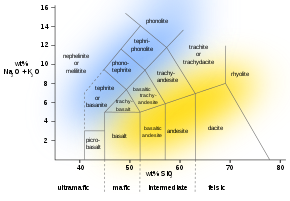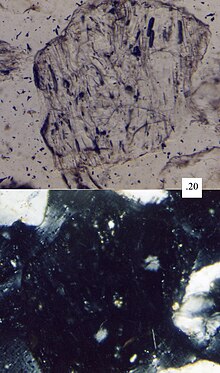Aphanite



Aphanite, or aphanitic as an adjective (from the Greek αφανης, "invisible"), is a name given to certain igneous rocks that are so fine-grained that their component mineral crystals are not detectable by the unaided eye[1] (as opposed to phaneritic igneous rocks, where the minerals are visible to the unaided eye). This geological texture results from rapid cooling in volcanic or hypabyssal (shallow subsurface) environments. As a rule, the texture of these rocks is not the same as that of volcanic glass (e.g., obsidian), with volcanic glass being non-crystalline (amorphous), and having a glass-like appearance.[2]
Aphanites are commonly porphyritic, having large crystals embedded in the fine groundmass or matrix. The large inclusions are called phenocrysts.
They consist essentially of very fine-grained minerals, such as plagioclase feldspar, with hornblende or augite, and may contain also biotite, quartz, and orthoclase.[1]
Common rocks that can be aphanitic
References
- ^ a b One or more of the preceding sentences incorporates text from a publication now in the public domain: Chisholm, Hugh, ed. (1911). "Aphanite". Encyclopædia Britannica. Vol. 2 (11th ed.). Cambridge University Press. p. 163.
- ^ Bates and Jackson, 1984, Dictionary of Geological Terms, 3rd ed., Prepared by the American Geological Institute
